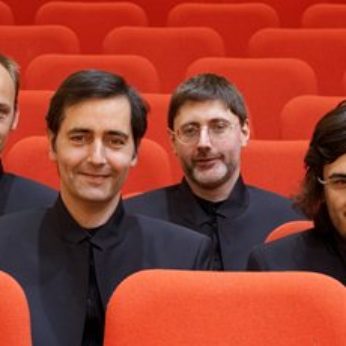Composer: Benjamin Britten (b. 1913 - d. 1976)
Performance date: 29/06/2013
Venue: St. Brendan’s Church
Composition Year: 1975
Duration: 00:25:27
Recording Engineer: Damian Chennells, RTÉ lyric fm
Instrumentation: 2vn, va, vc
Instrumentation Category:String Quartet
Artists:
Quatuor Danel (Marc Danel, Gilles Millet [violins], Vlad Bogdanas [viola], Guy Danel [cello]) -
[quartet]

The
campfire embers are black and cold,
The
banjos are broken, the stories are told,
The
woods are cut down and the young are grown old
from Paul
Bunyan – text by W.H.Auden, music by Britten [1940]
In February
1976, BBC Radio Three broadcast the first complete performance of Paul Bunyan for thirty-three years.
Britten was profoundly moved to re-encounter this forgotten work and all the
memories it aroused of Auden, of the American years, of his own youth, energy
and vitality, especially given his awful physical condition. In 1973 he had had
a major operation to replace the aortic valve in his heart. This bought him
three extra years but he was an invalid for the rest of his life, tiring very
easily and having huge difficulty composing.
The Third
Quartet was both Britten’s swansong and his homage to his great contemporary
and friend, Dmitri Shostakovich, who had died that summer. He began it soon
after completing Phaedra and he had four movements completed before
going on holiday – in a wheelchair attended by friends and a nurse – to
final opera completed two years earlier. It was in Venice he wrote the final Passacaglia, inevitably subtitled La Serenissima, the music recalling the bells of the church of Santa Maria della
Salute as well Death in Venice. As
with Shostakovich’s final work, the Viola Sonata, the composer did not live to
hear the premiere, which took place two weeks after his death.
Each of the movements has a subtitle, the
first, Duets, features the
instruments playing in pairs – each of the possible pairings of instruments
engage in an operatic duet while continually expanding its thematic ideas. This
gives the movement a strongly dramatic impetus and the various duets create
some remarkable sonorities. The first Scherzo, Ostinato, is brief and very violent with a quieter chorale-like
central section. The movement ends mid-phrase as if struck down.
The third, Solo, is intensely beautiful with the first violin soaring
stratospherically above the others with a deeply touching melody of a Bach-like
purity. The central section, Messiaen-like, bursts out into ecstatic birdsong,
afterwards the violin’s melody returns more movingly than before, while the
ending takes on a miraculous luminosity as the other instruments float up to
meet the violin.
Burlesque
is an obsessive dance, almost in the manner of
Shostakovich’s hard-driven Scherzos. The skeletal Trio is remarkable for the
eerie whistling sound produced by the viola playing behind the bridge. The
dance returns in a magnificently sonorous repeat. The finale’s operatic Recitative prepares us for the glorious
Passacaglia, whose calm, long drawn-out,
stately theme works its way almost unbearably into our hearts as we realise
this is a great composer’s last farewell. The final bars remain unresolved as
Britten himself said: I want the work to
end with a question.
Copyright © 2024 West Cork Music. All rights reserved.
Designed and developed by Matrix Internet